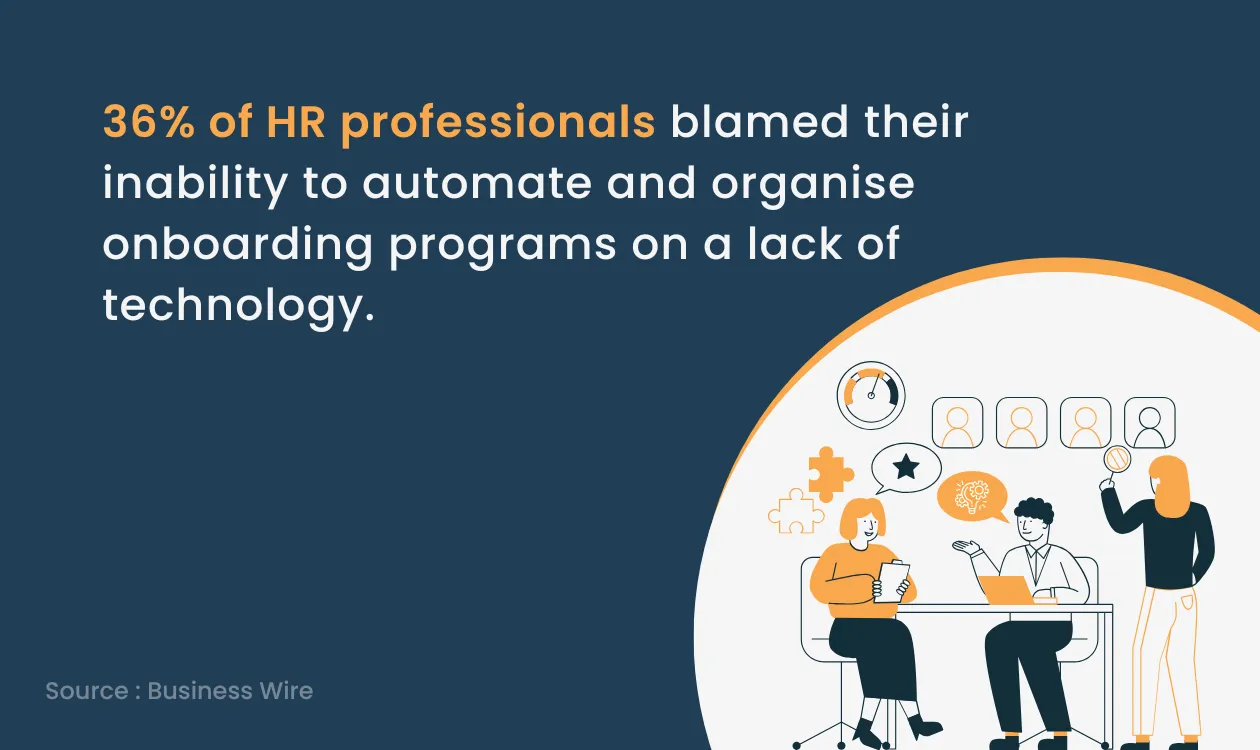Imagine this: You've just invested months in finding the perfect C-suite executive. The contract is signed, the announcement is made, and expectations are sky-high. Yet within six months, they're struggling to make an impact, team morale is wavering, and you're questioning whether you've made a costly mistake.
You're not alone. Reports indicate that only 27% of organisations effectively onboard their executives – a startling statistic that highlights why so many leadership appointments fail to deliver the expected results.
The difference between executive success and failure often lies not in the hire itself but in how well they're integrated into your organisation. Welcome to the comprehensive world of executive onboarding, where strategic planning meets leadership excellence.
But how can organisations achieve this?
You need to explore executive onboarding best practices if you want to know more about it. Let’s dive into the best practices for successful executive onboarding.
What is Executive Onboarding?
Onboarding a new leader is not that easy. Here, you'll find out the new leader onboarding best practices.
Executive onboarding is the process of integrating senior leaders into an organisation, ensuring they understand its strategic goals, culture, and operations. Executive onboarding differs from typical employee onboarding by centring on high-impact leadership integration. This process addresses key areas such as:
- Organisational vision and strategy
- Building relationships with key stakeholders
- Setting role-specific objectives
What are the Key Milestones in Executive Onboarding?
-
Pre-Boarding Preparations: Set the stage for success by providing relevant company information and aligning expectations before the executive’s first day.
-
Defining Key Success Metrics: Identify measurable outcomes for the first 3, 6, and 12 months.
-
Assigning Mentors or Onboarding Partners: Having senior leaders or board members mentor new executives and help them navigate organisational dynamics.
-
Communication and Team Integration Plans: The executive must build strong organisational relationships through meetings and feedback sessions.
Why is Executive Onboarding Critical for Organisations?
A well-crafted onboarding experience can significantly influence a company's overall achievements. Let’s explain how:
-
Impact on Company Culture: Executives set the tone for their teams. Proper onboarding ensures they embody and promote organisational values.
-
Reduced Risk of Failure: Poor executive integration can lead to costly turnover and disruptions.
-
Improved Leadership Effectiveness: Well-onboarded executives are more likely to contribute positively to business strategy, team performance, and growth.
For successful executive onboarding, an executive recruiter must understand their key responsibilities, enabling them to contribute effectively to organisational success.
Also, organisations need resources and time during executive onboarding. Let's dive into some challenges you might face while executive onboarding.
Common Challenges in Executive Onboarding
Even the most well-crafted executive onboarding plans can run into snags. Some typical hurdles include:
-
Conflicting Goals: If the executive and the organisation have different ideas about the job, it can create tension.
-
Fitting In: It can be challenging for new executives to get used to a new company culture, particularly when the company operates globally.
-
Resistance from Existing Teams: Senior teams or key stakeholders might be hesitant about changes, making it tricky for the new executive to gain respect and influence.
5 Best Practices for Effective Executive Onboarding
1. Clear Communication of Organisational Strategy and Vision
Executives need to grasp the complete picture of the organisation's mission, values, and long-term aims if they're going to align their leadership style effectively. This means they should get thorough briefings on the company's objectives, growth strategies, key initiatives, and stakeholder expectations.
Having regular sit-downs with key departments and board members can help solidify this understanding, allowing executives to make decisions that are well-informed and truly drive the business forward.
It's also beneficial for executives to learn from executive recruiter networking tips. These tips provide practical ways to connect with industry leaders and critical stakeholders. Doing so helps executives integrate more effectively and ensures their strategic goals align with the organisation.
2. Customising the Executive Onboarding Roadmap
Executives require a personalised approach during onboarding, as a universal strategy won't do. The onboarding process for each new leader must be customised to align with their specific job duties and individual leadership approach.
For example, a Chief Marketing Officer would benefit from spending time with the branding and communications teams. In contrast, a Chief Financial Officer might need a deeper dive into financial systems and regulatory compliance.
To keep the onboarding process effective and genuinely beneficial for each executive, it's crucial to review and fine-tune the plan regularly.
3. Involving Leadership and Board Members
Involving senior leaders and board members is essential for building alignment and trust. This can be done through strategy talks, mentor-mentee connections, and working together to tackle the organisation's hurdles.
Regular catch-ups with key stakeholders help boost teamwork and give executives valuable feedback on their progress. Board members can provide top-level perspectives on the organisation's strategy, which helps executives see the bigger picture of their role.
4. Leveraging Technology
Onboarding software with innovative AI tools can improve the executive onboarding experience. They automate tedious admin tasks and create custom learning journeys for each person.
Executive Onboarding Platforms are great because they help track key onboarding goals, smooth communication, and provide insights based on data to show how things are going.
These tools are super helpful for executives. They keep them on schedule, help spot potential problems early on, and provide instant feedback so they can adjust and fit in better.
Technology can make onboarding smoother by bringing together tools for tracking performance and fostering teamwork. By using Executive Search Software, organisations can enhance recruitment and streamline onboarding.
5. Continuous Training and Development
Executive onboarding really shouldn't just wrap up after the first three months. Executives must keep upgrading through ongoing training, leadership workshops, and coaching for long-term success.
Getting involved in industry-specific seminars, cross-functional projects, and mentorship programs allows executives to sharpen their skills and sync with the organisation's changing needs.
These initiatives promote adaptability, resilience, and innovation – all essential for sustained leadership success.
Role of Technology in Executive Onboarding
Technology is revolutionising the way organisations approach executive onboarding. AI-driven solutions like iSmartRecruit offer the following advantages:
- Candidate Tracking: Monitor onboarding progress and performance.
- Integration with HR and Performance Tools: Ensure seamless collaboration across departments.
- Custom Reporting: Analyse key metrics to optimise future onboarding efforts.
How to Measure the Success of Executive Onboarding?
How do you know if your executive onboarding efforts are successful? Here are key metrics to consider:
- Retention Rates: Track the percentage of executives who stay beyond the first 12 months.
- Time to Productivity: Measure how quickly the executive reaches full performance potential.
- 360-Degree Feedback: Collect feedback from peers, subordinates, and senior leaders.
- Long-Term Contribution: Evaluate the executive’s impact on achieving strategic goals over time.
Conclusion
A carefully crafted plan for executive onboarding can make all the difference between a flop and a triumph. Each stage of this process is vital, from outlining clear goals to making the most of available technology.
Businesses that strongly emphasise a well-organised onboarding experience tend to keep executives longer, see them become productive more quickly, and enjoy better results from their leaders.
In today's tough job market, nailing the executive onboarding process isn't just a good idea; it's necessary.
If your organisation blends an intense onboarding process with a strategic executive search, you'll set yourselves up for lasting success. Dive into our comprehensive blog, Executive Search: The Key to Finding Top Leaders, for a deep dive into the entire lifecycle of hiring and developing top-tier executives.
Thanks to tools like iSmartRecruit, companies can make this process much easier and help their new leaders hit the ground running.
FAQs - Frequently Asked Questions
1. What is executive onboarding, and why is it important?
Executive onboarding is the process of integrating senior leaders into an organisation by aligning them with the company’s culture, goals, and key stakeholders. It’s critical because it sets the foundation for long-term success, reduces turnover risk, and ensures leadership alignment from day one.
2. How is executive onboarding different from regular onboarding?
Unlike regular onboarding, executive onboarding focuses on leadership integration, strategic goal alignment, and relationship-building with key stakeholders. It’s more personalised and involves higher-level planning and decision-making responsibilities.
3. What are the top challenges in executive onboarding?
Common challenges include cultural misfit, resistance from existing teams, conflicting role expectations, and a lack of a structured onboarding strategy. These issues can delay integration or reduce executive effectiveness.
4. How long should the executive onboarding process last?
Executive onboarding typically lasts 6 to 12 months, with key milestones at 30, 60, 90, and 180 days. Ongoing support, feedback, and development should continue beyond the first quarter.
5. What role does technology play in executive onboarding?
Technology like AI-powered onboarding platforms (e.g., iSmartRecruit) automates admin tasks, tracks performance, and customises onboarding paths. It helps executives stay on schedule, improves communication, and provides data-driven feedback for better integration.
6. How do you measure the success of executive onboarding?
Success is measured by retention rate after 12 months, time to productivity, 360-degree feedback, and the executive’s long-term impact on strategic goals. Monitoring these metrics helps refine onboarding strategies over time.











.webp.dat)





